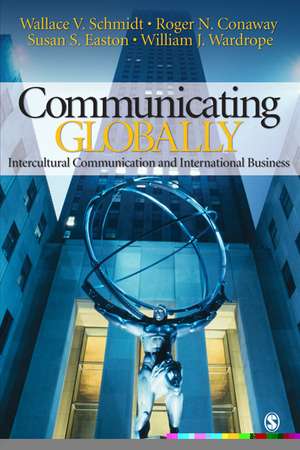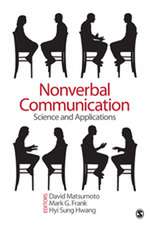Communicating Globally: Intercultural Communication and International Business
Autor Wallace V. Schmidt, Roger N. Conaway, Susan S. Easton, William J. Wardropeen Limba Engleză Paperback – 4 apr 2007
The book discusses the implications of these approaches and the new competencies needed for conducting international business and entering the world marketplace. It examines intercultural transitions and cross-cultural relationships as well as how virtual groups or teams and constant change influence multinational organizations.
The book further provides insights into doing business abroad by examining significant geographic regions and emphasizing cultural themes and patterns, business conduct and characteristics, and emerging trends. Also included is a regional resource guide that establishes a sensible foundation for readers to continue their own cross-cultural or international business research, personally transforming their understanding into individually instructive significance.
Preț: 842.07 lei
Preț vechi: 1026.91 lei
-18% Nou
161.12€ • 168.24$ • 133.05£
Carte tipărită la comandă
Livrare economică 15-29 aprilie
Specificații
ISBN-10: 1412913179
Pagini: 336
Dimensiuni: 152 x 229 x 18 mm
Greutate: 0.45 kg
Ediția:1
Editura: SAGE Publications
Colecția Sage Publications, Inc
Locul publicării:Thousand Oaks, United States
Recenzii
"The insight supplied is based on research and application that can permit you to make necessary choices and decisions. This is definitely an excellent book for advanced courses in the field of international business communication."
Cuprins
UNIT ONE: KEY CONCEPTS
1. The Concept of International Business and a Global Marketplace
Why Study Global Communication and International Business
International Business, Globalism, and the Nature of Global Communication
Political Issues and Globalization
Economic Issues and Globalization
Technological Issues and Globalization
Training Challenges of a Complex Intercultural World for International Business
Summary
2. The Concept of Intercultural Communication and the Cosmpolitan Leader
Defining Culture and Cultural Patterns
The Interface of International Business, Culture, and Communication
Cosmopolitan Leadership and an Emerging World Culture
Summary
3. The Concept of Cultural Synergy and the Global Organization
The Emerging Global Landscape
The Reconfigurable Organization and Globalism
Corporate Cultural Models and Critical Cultural Factors
Globalism and Cultural Synergy
The Virtual Organization, Cultural Synergy, and the Global Marketplace
Summary
UNIT TWO: DEVELOPING NEW SKILLS AND INTERCULTURAL COMPETENCIES
4. Cultural Contact and Interfacing With Others
Relational Dialectics and Cultural Contact
Adaptation and Building Intercultural Relationships
Intercultural Effectiveness and Cross-Cultural Competencies
An Expatriate's Journal: A Three-Year Sojourn In Singapore
Summary
5. The Nature of Language and Nonverbal Communication
Characteristics of Language
Nonverbal Communication
Summary
6. Intercultural Communication and Conflict Management
Defining Intercultural Conflict
Phases of Intercultural Conflict
Characteristics of Intercultural Conflict
Steps in Constructive Intercultural Conflict Management
Conflict Negotiation, Mediation, and Arbitration
Summary
UNIT THREE: INTERCULTURAL COMMUNICATION AND THE NEW WORLD OF BUSINESS
7. Cosmpolitan Leadership, Teams, and the Global Workforce
Cosmopolitan Leadership and Leadership Competencies
Cosmopolitan Leadership and Global Teams
Decision-Making, Problem-Solving, and the Global Teams
The Global Workforce and Technology
Summary
8. Disturbing the Equilibrium and Creating Planned Change
Chaos, Change, and Innovation
Strategies for Innovation and Change: Theoretical Frameworks
Communicating About Changes
Cross-Cultural Considerations for Implementing Change
Taking the Long View: Seeing the Future
Summary
UNIT FOUR: ENTERING THE GLOBAL MARKETPLACE AND WORLD BAZAAR
9. Doing Business in North America
Geography and Demographics
Case Study: The Growing Latin American Population
Cultural Themes and Patterns
Social, Economic, and Political Factors
Case Study: The Cost of Terrorism
Business Conduct and Characteristics
Emerging Trends
Summary
Resource Guide
10. Doing Business in Latin America and the Caribbean
Geography and Demographics
Cultural Themes and Patterns
Social, Economic, and Political Factors
Trade and Economic Integration
Case Study: The Mexican Peso Crisis
Business Conduct and Characteristics
Emerging Trends
Summary
Resource Guide
11. Doing Business in East Asia and the Pacific Rim
Geography and Demographics
Cultural Themes and Patterns
Case Study: How Cultural Factors Contributed to the 1997 Asian Economic Crisis
Social, Economic, and Political Factors
Business Conduct and Characteristics
Case Study: The Sino-Japanese Struggle?--Who Will Trump Asia?
Summary
Resource Guide
12. Doing Business in Europe
Geography and Demographics
Social, Economic, and Political Factors
Trade and Economic Integration
The European Union and the Euro
Case Study: The Russian Federation
Business Conduct and Characteristics
Emerging Trends
Summary
Resource Guide
13. Doing Business in Africa and the Middle East
Geography and Demographics
Cultural Themes and Patterns
Culture, Language, and Religion
Social, Economic, and Political Factors
Business Conduct and Characteristics
Emerging Trends
Summary
Resource Guide
Epilogue: Breaking Free and the Road Ahead
References
Notă biografică
Wallace V. Schmidt (Ph.D., New York University; M.A., University of Nebraska; B.A., Midland Lutheran College) routinely teachesa courses in organizational communication, intercultural communication, and communication theory, retinue of elective courses at both the undergraduate and graduate levels (e.g., interviewing; persuasion; training & development. He is the 1992 recipient of the Walter E. Barden Distinguished Teaching Award, past president of the Florida Communication Association, and co-author of two successful textbooks: Results-Oriented Interviewing: Principles, Practices, and Procedures (Allyn & Bacon/Pearson Education) and Business and Professional Communication: Managing Information in an Information Age (South-Western/Thomson Learning).







